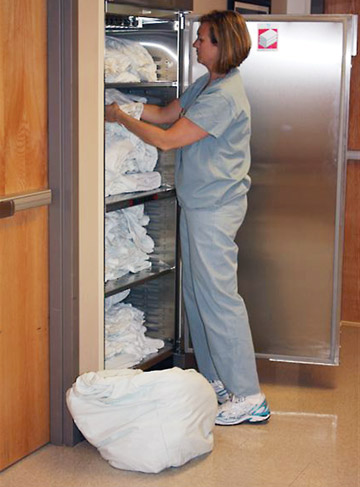In my quest to right the trend on SSIs, I collaborated with nursing, surgical and anesthesia leaders to develop a colon bundle for our facility. Active patient warming, which occurs throughout the entire surgical episode, is a major component
of the bundle. To ensure our staff follows standardized warming protocols, I created a guideline for preventing IPH (you can access it here: osmag.net/forms). Here are some of
its key elements:
- Know the risks. There are several factors that exacerbate the risk of IPH and preventing it starts with the patient assessment. Staff need to be aware of hypothermia's risk factors (note them in your warming policy) and
pay extra attention to patients who exhibit them.
Pediatric patients and geriatric patients are most at risk. People with a low BMI (17 or below) and patients on psychotropics, antidepressants and thyroid supplements are also susceptible. Procedure type and anesthesia technique also play
a role. For example, patients undergoing procedures requiring placement of a pneumatic tourniquet are more at risk for IPH. Those who receive spinal anesthesia or regional blocks are at double the risk because the blocks impact the sympathetic
vasoconstrictor and vasodilator ?systems, which affects the body's thermoregulation.
- Temperature monitoring. Standardized temperature monitoring methods should be explicitly spelled out in your warming policy. You might have noticed some staff members take oral temperature readings and others opt for an
axillary measurement — perhaps for the same patient. These methods simply aren't equitable and are an inconsistent method of temperature taking could impact the effectiveness of your warming practices. It's essential to get buy-in
for a standardized monitoring method by including it in your guidelines. For example: "Tympanic measurement is our standard. We'll use it pre-op, intra-op and post-op."
If your facility decides upon a different standard, that's fine. Pick one and stick with it. If you're unable to use that method due to the patient's health status or procedure type, have a designated backup method in place.
Passive warming with a cotton blanket is an inefficient and ineffective way to warm patients.
Mistakes are often made with temperature maintenance. All too often, a patient gets wheeled into the OR, her temperature gets recorded and staff think, "36.4 ?C, great. The patient's warm." Then what happens? They spend time positioning and
prepping the patient and conducting the pre-procedure time out without actively warming the patient. By the time the surgeon is ready to make the incision, the patient's temperature has dropped. That's potentially problematic because general
anesthetics cause vasodilation, especially during the first hour after induction, letting the body's core heat flow to the extremities. Prewarming and active warming in the OR builds up a patient's temperature reserve to lessen anesthesia's
impact on core body temperature.
- Pre-op warming. The only effective type of prewarming is active warming, which includes forced-air and conductive warming. It's a method recommended by professional associations such as ASPAN, AORN, ASA and IHI. Our guideline
requires active prewarming for a minimum of 30 minutes for patients scheduled to undergo procedures lasting 30 minutes or more. But that time frame can be deceiving. Take a simple lipoma removal. The procedure only takes about 20 minutes
to perform, but a patient could be in the OR for 30 to 45 minutes in total. That's why our warming policy isn't based strictly on procedure time; we consider how long the patient will be in the OR. For that reason, we prewarm most
patients.
Despite active warming's clear benefits, plenty of surgical facilities still give patients a warmed blanket in pre-op and consider that acceptable. It's not. Cotton blankets might make patients feel warm and comfortable, but research shows
the heat they give off lasts for only about 10 minutes and does not impact core body temperature.
Passive warming with a cotton blanket also isn't an economic choice because it increases linen costs and linen inventory. Staff must dedicate time to loading blanket warming units and reapplying blankets in pre-op. That's a lot of inefficiency
for no gain in clinical outcomes.
Cost is often cited as a barrier to implementation of active warming methods. To gain buy-in for active warming, consider you'll be saving money on postoperative morbidity. Warm patients wake up quicker because they metabolize anesthetics
at an increased rate. They're able to fight off infection because their tissue oxygenation levels are higher. They heal better and they're more comfortable.
- Intraop warming. Continue the warming method that was initiated in pre-op when patients enter the OR. For procedures lasting longer than 30 minutes, increase the ambient room temperature and, if appropriate, ask the surgeon
to use warmed irrigation solutions. This should be an agreed upon methodology between surgery and anesthesia leaders.
- Post-op warming. Patients can lose 0.5 ?C to 1.5 ?C of their body temperature as they recover in the PACU. Regularly monitoring the patient's temperature therefore remains imperative during the post-operative phase.
.svg?sfvrsn=be606e78_3)

.svg?sfvrsn=56b2f850_5)